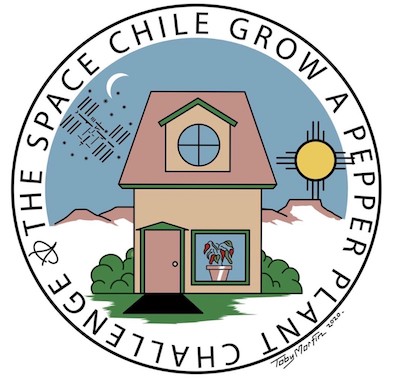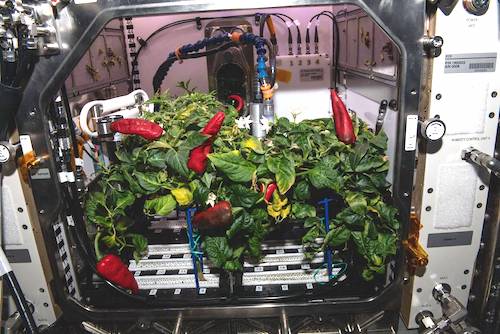NASA’s First Pepper Pollination and Harvest in Space
by Christina Tyler Wenks, Fairfax Master Gardener
 Seeds sent and exposed to space have been shared and grown on Earth for years, but due to microgravity’s environmental stresses, astronauts are just starting to grow, pollinate and harvest vegetables on board the International Space Station. Students, educators and NASA scientists are learning the value of crowd-sourcing research, which expedited the first fruit harvest in space.
Seeds sent and exposed to space have been shared and grown on Earth for years, but due to microgravity’s environmental stresses, astronauts are just starting to grow, pollinate and harvest vegetables on board the International Space Station. Students, educators and NASA scientists are learning the value of crowd-sourcing research, which expedited the first fruit harvest in space.
In microgravity, water holds a spherical form and does not flow, so delivering water to plants on the International Space Station is tricky. The absence of gravity makes plants grow in all directions, not necessarily up.
Master gardeners, citizen scientists, educators and students are among the thousands that helped NASA determine the best pepper variety to grow in space, simulate unpredictable and harsh environments, and test reliability of various methods to supply water and nutrients in an artificial plant habitat.
“We successfully grew the first fruit in space. It was the most successful, most watched space biology mission in history,” said Jacob Torres, who works at Kennedy Space Center and created The Space Chile Grow a Pepper Plant Challenge.

Planting curiosity and growth opportunity
NASA JPL Solar System Ambassador Dan Leppold, who teaches sciences at Spring-Ford High School in Royersford, Pennsylvania, asked me, a Virginia Cooperative Extension certified master gardener in Fairfax County, Virginia, to join his school’s space seed experiment and test seeds sent to space.
A balloon carrying student experiments from throughout the country was launched from Colorado and ascended to 106,000 feet to the edge of Earth’s atmosphere before bursting and falling back to farm fields where the experiments were retrieved. Edge-of-space seeds were sent back to us educators, who grew the seeds in labs and in a variety of conditions. Leppold’s class tested bacterial differences and more.
About the same time, another Solar System Ambassador in Arizona suggested I participate in The Grow a Space Pepper Plant Challenge at Kennedy Space Center and compare an organic, single-source pepper seed’s reliability and resilience. The challenge encompassed ascertaining growth outcomes in harsh environments, some simulating soils and conditions found on other planets.
I accepted the simultaneous invitations to grow space veggies. The chance to witness and measure outcomes of varied exposures to space, share with students and contribute to NASA’s research was thrilling.
Scientist Jacob Torres hails from New Mexico where NASA’s single-source Chimayo seed is cultivated. He asked participants to experiment with specific soils and light as well as a variety of watering techniques and hydroponic environments. Conversation grew among hundreds of us around the world who documented germination, average temperatures and humidity, heights and fruit production. We shared findings and problems, such as plant fungus, via social media and a shared online database. We dried and crushed our fruit for University of New Mexico researchers to measure capsaicin and nutritive value.
My home loft averages a consistent temperature and humidity similar to the International Space Station. The room seemed a good place to create an artificial plant habitat (APH) with grow-light specifications shared by Torres that are similar to those aboard the ISS. Identical pots containing measured soil and water delivery methods were placed under grow lights in my APH. For comparison, an outdoor “control plant” helped assess growth rate in optimum Northern Virginia’s Zone 7 conditions. A wild-card second control plant was placed in my kitchen windowsill, because with additional sunlight and air circulation, anything can grow there.
“The Space Chile Grow a Pepper Plant Challenge was the first time that Earth-based citizen farmers grew along with an active NASA space biology experiment,” said Torres. “During 2020–2021, space farmers showed that these peppers can grow in many varying controlled environments through trials in classrooms and growth chambers around the world.”
Torres asked participants to brainstorm ways to stress pepper seeds. Considering this project’s intent was to grow peppers in space, I seized the opportunity to stress my seeds by sending them to the edge of space via a high-altitude balloon with little protection. A foam box held seeds from the Spring-Ford High School class and my “space peppers” seeds to see how the Chimayo pepper might respond differently from other experiments.
 My space chile seeds were divided into four equal groups — two earth-bound and two space-bound clusters. One set of each grew in Northern Virginia and the other set was sent to Torres to grow and examine in NASA’s lab.
My space chile seeds were divided into four equal groups — two earth-bound and two space-bound clusters. One set of each grew in Northern Virginia and the other set was sent to Torres to grow and examine in NASA’s lab.
I sprouted seeds from Torres and Leppold, recorded germination rates, compared cotyledons, daily hours of light, water, temperature, humidity, dates of flowering and fruit stages and submitted data to Torres’s team of researchers collecting and comparing data to assess decisions about peppers growing in space.
We experimented with various watering and fertilization techniques, such as wicking water to roots in growth media. Wicks made of various materials transfer water and deteriorate at different rates. We compared notes and realized that the magnitude of experimentation expedited research beyond the ISS to potentially growing in another planet’s soil.
Research results
Plant-growth science takes a little longer than the average chemistry-lab experiment, and research requires duplicating or triplicating results to establish probability of growth success.

Peppers grown in space
Seeds sent to space seemed stimulated to grow and fruit faster than identical, same-sourced seeds that stayed on Earth. Leppold’s science classes witnessed the abundance of tomatoes and peppers from space seeds as compared to their earth-bound batches. The high-school students experimented with alfalfa and tree seeds such as Gingko, too.
My space veggie outcomes mimicked Leppold’s science class. My personal supply of space chives did not sprout, which could be due to a number of factors. My wild-card windowsill plant produced the most productive space peppers probably because of differences in natural lighting and humidity. NASA’s single-source pepper seeds sent to the edge of space germinated days faster, produced more flowers and more fruit than the earth-bound seeds in my loft lab, too.
“The Martinez Chimayo [pepper seed] was sent and grown by farmers like you who sent them to the stratosphere and grew them on five continents, including Antarctica,” Torres shared. “Here’s the real question: Has another cultivar been sent and grown successfully in so many different environments and places in history?” said Torres.
All data collected furthers future NASA missions.
“The most healthy and productive peppers were grown in the CO2 [carbon dioxide] controlled environment,” Torres said.
Before NASA’s Plant Habitat-04 peppers were sent to space, plants had not grown longer than 35 days aboard the ISS. PH-04 is the first successful demonstration of growing, hand-pollinating and fruiting in space over 137 days, and 17 peppers grew.
“These fundamental things have never been done in space until now,” he said.
While living in microgravity, astronauts often experience a decrease in taste and ask for hot sauce and spicy foods, so they celebrated their pepper harvest with dinner.
“Actual growth on ISS showed delayed fruiting by 14 days. The plants were smaller, more compact than any we ever grew on Earth. The peppers grew up instead of hanging down from the plant,” explained Torres. “The theories for why we had delayed fruiting are still out there and is something that I have been working to replicate in the lab, but stress due to the environment is most likely.”
Sharing outcomes of NASA’s Grow a Space Chile Pepper Plant Challenge and my personal seed experiments generates excitement for the next round of experiments and the next generation.
“With Artemis and the missions to return to the moon on the way — this time to stay, astronauts will need fresh crops to supplement their diets more than ever,” Torres said. “When reviewing which crop is best to lead the way, it is best to demonstrate long term growth, [to] fulfill pollination, and provide a fruit with vitamins and fresh nutrients. Our database of growth from around the world in many environments and in space provides NASA with a great reference of a good bet.”
By mailing thousands of seed packets around the world for the Grow a Space Chile Pepper Plant Challenge, Torres cultivated a community of space farmers who are eager to grow and learn more. The documented success of the space pepper provides a starting point for growing plants on the lunar surface in controlled environments. With Artemis mission science underway, Torres said the next chapter of citizen science to fulfill plant growth that accompanies NASA human exploration is coming.
Prospective space farmers may learn more and get involved by perusing links throughout the provided resources.
Resources
The Space Chile Grow A Pepper Plant Challenge, NASA
NASA’s second pepper harvest in space, NASA
NASA’s Plant Habitat-04
ISS National Laboratory Center for the Advancement of Science in Space
Seeds in space, Park Seeds
Space Station Seed Studies Cultivate Student Scientists